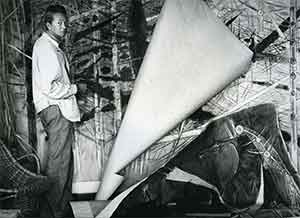Wifredo Lam. Painting as act of decolonisation

Francesco Carelli, University Milan, Rome
 “My painting is an act of decolonisation ” the Cuban artist stated ” not in a physical sense, but in a mental one “. Lam belonged to an extraordinary generation of artists who examined the place of the individual within twentieth – century society, marked by political conflict and the legacy of colonialism. His work was revolutionary in overturning cultural hierarchies through its emphasis on Afro – Caribbean culture. He developed a unique style that represents a highly distinctive point of convergence between modernist movements .
“My painting is an act of decolonisation ” the Cuban artist stated ” not in a physical sense, but in a mental one “. Lam belonged to an extraordinary generation of artists who examined the place of the individual within twentieth – century society, marked by political conflict and the legacy of colonialism. His work was revolutionary in overturning cultural hierarchies through its emphasis on Afro – Caribbean culture. He developed a unique style that represents a highly distinctive point of convergence between modernist movements .
The Ey Exhibition: Wilfredo Lam at Tate Moern presents a chronological survey of the artist’s rich and complex career. Born in Cuba in 1902, he studied in Havana and Madrid. He enlisted with the Republican forces in the Spanish Civil War, and was in Paris at the outbreak of the Second World War. Returning to Cuba in 1941 as part of the exodus of refugees fleeing the German occupation, Lam was confronted with the poverty and corruption of his homeland, but also began to explore its African heritage. Over the following decade he developed the characteristic imagery of his paintings, drawing upon the rituals and symbolism of the Afro-Cuban Santeria religion. Returning to Europe in 1952, he lived variously in France, Switzerland and Italy, before his death in Paris in 1982.
Been part of a vibrant cultural circle in Madrid in 1936, Lam volunteered for the Republican militia, working in a munitions factory but, after six months handling toxic substances, his health deteriorated and he withdrew to Catalonia to recuperate. The tragedy of the Civil War became a frequent theme in his paintings, which concentrated on simplified and schematized figures. Placing his art at the service of the Republic he also made images reminiscent of Goya, condemning the horrors of war.
In France, Picasso admired Lam’s work and provided him with vital contacts. When the German invasion forced to flee from Paris in June 1940, Lam, in Marseille, became part of a community of refugees, gravitating to the circle around the surrealist leader Andre Breton.
In August 1941, Lam returned to Cuba. After eighteen years away, he became acutely aware of its decadence, racism and poverty, but also rediscovered the natural landscape and became fascinated with the Santeria religion, in which rituals and beliefs from West Africa were overlaid with aspects of Catholicism.
Over the next decade, Lam developed a personal style that allowed him to combine his artistic and political experience in Europe with his rediscovery of Afro – Cuban culture. He infused his paintings with the imagery and energy of Santeria, showing hybrid figures which sometimes included details relating to specific Yoruba deities or Orisha. Huge hybrid figures perform in a shallow space created by combining precise drawing with flickering brushwork.
Several paintings incorporate the figure of the femme-cheval or “ horse-headed woman “. During Vodou and Santeria rituals, known only to initiates, the worshipper is allegedly taken possession of , or “ridden”, by a spirit. Over time, the horse-headed women of Lam’s paintings gradually acquired more identifiably human and eroticized attributes. This was an oblique reference to the exploitation of women of mixed-heritage in Cuban society, some of whom were forced, through poverty, into prostitution.
Lam was also in continual contact with Breton, now based in New York. For Breton the painter represented a further renewal of surrealism, shared with contemporaries such as Roberto Matta and Arshile Gorky. As a result, Breton promoted several of Lam’s exhibitions at the Pierre Matisse Gallery in New York.
In 1954, Lam was invited by Asger Jorn to participate in the International Meeting of Sculpture and Painting in Albissola Marina, an Italian seaside town renowned as a historic centre of ceramic production. After the Second World War, a number of international and politically idealistic artists had settled there and were regular visitors. Jorn himself was a founding member of CoBrA, an avant-garde group which rejected European high cultural tradition, and of the experimental Situationist International. Lam found Albissola and this liberal community of artists an appealing prospect and returned regularly, setting up a permanent studio there in 1962.

